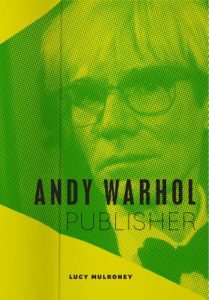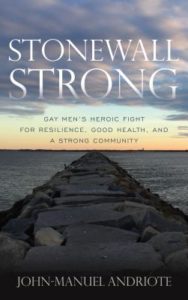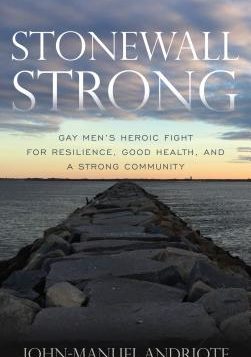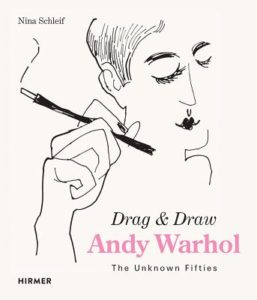 Andy Warhol, Publisher
Andy Warhol, Publisher
by Lucy Mulroney
Univ. of Chicago Press. 176 pages, $45.
Based in part on the author’s 2013 doctoral thesis of the same name, this book is not an overview of Warhol-as-publisher but rather a close look into the background of six of his “publishing practices.” About forty illustrations, all black-and-white, are included. Some of the material covered will be familiar to attendees of Warhol by the Book, a 2015 exhibition that began at the Williams College Museum of Art. One of the earliest works that Mulroney, an art historian and Warhol specialist, chooses to focus on is 1954’s 25 Cats Name Sam and One Blue Pussy (the title was never corrected to “named”), which “pokes fun at heteronormative constructs [and]parodies the conventions of publishing.”
Mulroney also details some of the “little magazines” for which Warhol designed covers, plus books that went against the expected styles of the time. One was Andy Warhol’s Index (Book), a pop-up book for adults published in time for the 1967 holiday season, filled with obscure jokes, interviews, a pop-up can of Hunt’s tomato paste, and a 45-RPM record. The title was an allusion to the Catholic Church’s index of prohibited literature. The chapter on Interview magazine includes a full-page reproduction of the results of 1978 subscriber survey, pointing out how wealthy and culturally hip its readers were at the time. Taken as a whole, this work of scholarship fills some gaps in our knowledge about another side of Warhol’s multifaceted career.
Martha E. Stone
Art historian and curator Nina Schleif argues in Drag & Draw Andy Warhol that the artist’s pre-superstar-period drawings remain relatively underappreciated. This beautiful book corrects some of that neglect by including two series of drawings by Warhol: those highlighting his nascent fascination with cross-dressing and gender play, and an olio of photos and images from the period. Schleif speculates that Christine Jorgenson’s celebrity (as an early high-profile male-to-female trans person) and filmmaker Ed Wood’s cult oddity Glen or Glenda? must have had an impact on the young Warhol. After all, Warhol’s early work exuded a camp sensibility. One striking thing about these drawings is how they managed to be both innocent and naughty simultaneously. Given the laws surrounding homosexuality and cross-dressing at the time, they are undeniably subversive. Concludes Schleif: “the act of drawing immediately influenced and reflected Warhol’s identity as a gay man. … [C]learly the drawings discussed in this book are not lightweight. Discarding them so easily has kept us from seeing a fascinating side of the young Andy Warhol.” Just when you thought there wasn’t anything new to learn about Warhol, this book offers an insightful, informative look back at these portraits by the artist as a young man.
Matthew Hays
 In Your Hands
In Your Hands
by Inês Pedrosa
Translated by Andrea Rosenberg
Amazon Crossing. 205 pages, $14.95
This novel, translated from the Portuguese, follows the lives of three generations of women through journal entries, commentaries, and letters. The story begins with Jenny in the 1930s, who marries António, a homosexual, and winds up sharing her life with him and his lover Pedro. The story then follows their daughter Camila, who becomes a photographer and soon runs afoul of the government during Salazar’s dictatorial regime. It concludes with the granddaughter, a mixed-race child who seeks answers to her family’s complicated life by searching for her father and redemption in Mozambique.
As intriguing as it may sound in summary, the novel itself is a good deal less satisfying. There’s a significant lack of grounding for all of the characters, and details of Salazar’s rule—which might have clarified the motivations of the characters—are never provided. Curiously, for a book comprised of letters and journal entries, there isn’t a lot of
insight into each character’s motives. Why, for instance, is Jenny so devoted to António and Pedro—so willing to give up her own claims to love? What are Camila’s feelings about politics and the government? While we’re told a great deal about what happens to these women, we really never get a sense of what makes them tick.
Dale Boyer
 Stonewall Strong: Gay Men’s Heroic Fight for Resilience, Good Health, and a Strong Community
Stonewall Strong: Gay Men’s Heroic Fight for Resilience, Good Health, and a Strong Community
by John-Manuel Andriote
Rowman & Littlefield. 311 pages, $36.
John-Manuel Andriote documented gay men’s suffering during the AIDS crisis in his highly acclaimed book, Victory Deferred: How AIDS Changed Gay Life in America. In Stonewall Strong, he has written what he describes as “a bookend to Victory Deferred,” a book about resilience, survival, and heroes. The book’s overriding theme is “the liberating power to be unleashed … by triumphing over the obstacles put in our way as we pursue our own heroic journey.” Andriote argues that gay men face an inherent obstacle of being marginalized for their sexuality, which forces them to find resilience and strength within themselves to fight back. He makes his case through example after example, showing how gay men have heroically made this journey and found the inner strength to thrive and make a difference. Following the euphoria of Stonewall and the 1970s, we were suddenly under siege on three fronts: by the deadly AIDS virus, by a homophobic government that ignored the crisis and rejected demands for LGBT equality, and by the ongoing battle with anti-gay prejudice and internalized homophobia. Through the trauma of these times, gay men persevered, survived, and even flourished. It is a story of resilience that Andriote tells with personal commitment and passion.
William Burton







